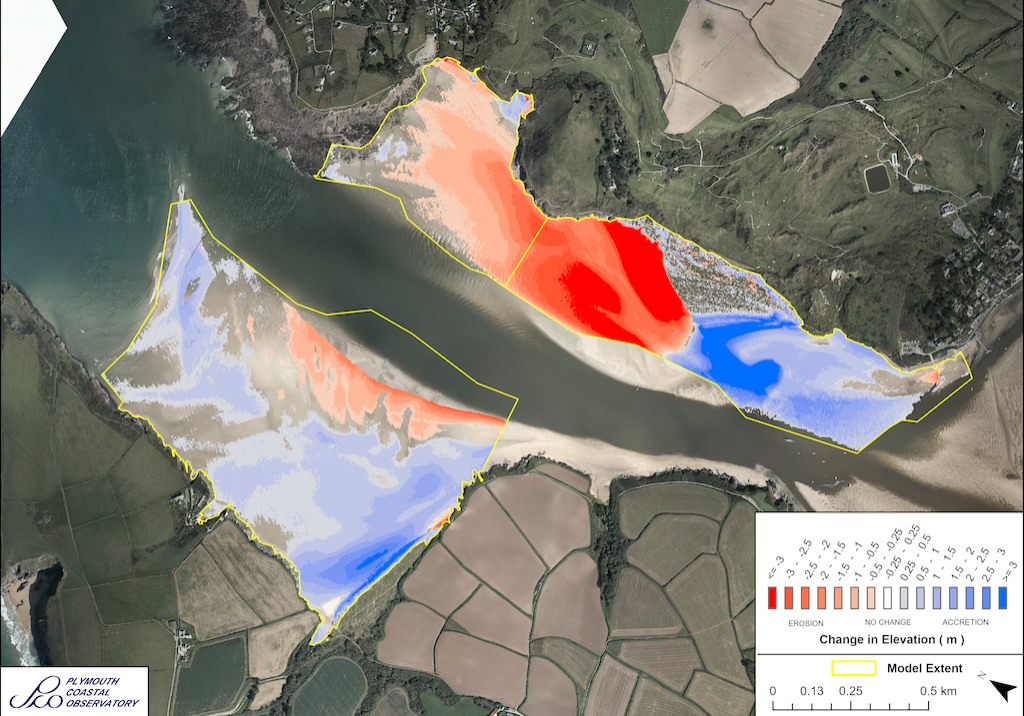
Rock (Cornish: Penmayn, meaning ‘end of stones’) was also known as Black Rock and now abbreviated to Rock. It is believed this name originates from the quarry, which is now used as a car park. Rock has an extensive dune system that stretches along the eastern bank of the Camel Estuary to Daymer Bay.
The estuarine dune system is influenced not only ebb and flow of the tide but also by the constant flow of the River Camel. The amount of energy within the mouth of the River Camel means that sediment movement can be significant, resulting in the dunes building and potentially eroding over a relatively short period of time.
The dunes associated with Rock climb to significant height. As the tide drops within the estuary it’s possible to walk along the toe of the dune system, where, in places, the dark rocks of the low cliffs contrast with the yellow fine sand that sits upon it. This more resilient rock is not visible along the entire length of the dunes and erosion events can remove tons of sand almost overnight.
Though large areas of Rocks Dune system remain undeveloped, the village of Rock has spread to the quarry carpark and large areas of the dune system have been developed as a golf course.


Coastal Change
The coastline of Cornwall is an ever-changing environment. It is energetic, dynamic, never still and changes with each wave and each tidal cycle. Some of the changes we see are gradual and barely noticeable, whilst others, such as rockfalls, happen suddenly and often shockingly.
From one visit to the next it can sometimes be difficult to see how a beach and dune system has changed, but information has been collected, and is being collected through the Making Space for Sand project, to help us better understand how the coastline is changing. The purpose of this section of the website is to understand each location has changed over time, how it could change in the future and understand the policies that influence how we can respond to these changes.
Shoreline Management Plan (SMP)
The Shoreline Management Plan (SMP) is a strategic planning and management assessment tool that helps identify and measure the risk associated coastal erosion and coastal flooding. The document makes a number of policy recommendations over short, medium and long term timeframes setting out a strategic approach to managing the built, natural and historic environments associated with the coastline. Within SMP there are four policy approaches which have been assigned to stretches of coastlines. The four policies are: No Active Intervention (NAI), Hold the Line (HTL), Managed realignment (MR), and Advance the line (ATL).
Rock sits within Policy Development Zone 14 (PDZ14), in Management Area 35 (MA35), within Policy Unit (PU) 35.10, 35.11 and 35.12. The policy recommendations for this policy unit are detailed in the table below and the SMP can be accessed through the Cornwall Council website.
Use your touchscreen
to scroll the below table
| Policy Unit | SMP2 Policy Plan | ||||
| 2025 | 2055 | 2105 | Comment | ||
| 35.10 | Porthilly Cove
Main Policy Sub Policy |
NAI LAO |
NAI LAO |
NAI LAO |
This approach allows the natural evolution of the shoreline to occur to support conservation of designated features. Flood resilience for a small number of properties currently at flood risk will need consideration as risks are increased with sea level rise. This includes listed buildings behind low lying estuary walls that will need to be defended. |
| 35.11 | Rock
Main Policy Sub Policy |
HTL RnR |
MR P |
MR P |
The intended plan for Rock, from and including the existing defences to the east of the Sailing Club to the end of the coast protection structure at the start of Rock Dunes is hold the line for the first epoch, with managed realignment in the second and third epochs. Managed realignment will allow a more sustainable shoreline position to be achieved along the Rock frontage, with the hold the line policy in the first epoch allowing the important estuary access points and buildings associated with the RNLI and sailing and recreational activities to be moved to sustainable positions.
This approach allows the objectives of supporting coastal communities and recreation and tourist opportunities, while managing erosion and flood risks in a sustainable manner, with flood resilience required as flood risks increase with sea level rise. |
| 35.12 | Rock Dunes and Daymer Bay
Main Policy Sub Policy
|
NAI DnD |
NAI DnD |
NAI DnD |
Policy intends to allow natural coastal evolution to support the nature and conservation values as there is little change expected to shoreline position over the three epochs. There are no assets at risk of flooding or erosion other than a small number of Scheduled Monuments, one of which includes the Rock Ferry landing stage.
This area is a popular amenity dune and beach area and in part forms the SW coast path and it is reported that since SMP policy was adopted, erosion has increased and so policy review is recommended even though not identified in SMP-R health check report. |
| Key Main Policy: HTL - Hold the Line, A - Advance the Line, NAI – No Active Intervention, MR – Managed Realignment
Sub Policy: LAO – Local Activity Only, RnR – Repair not Replace, P – Placeholder, DnD – Do not Defend |
|||||


National Coastal Erosion Risk Mapping (NCERM)
National Coastal Erosion Risk Mapping (NCERM) provides a baseline of coastal erosion, for the coastline of England, over short, medium and long-term timeframes. The data is based on the natural and defence characteristics of the coastline and provides rates of erosion at differing levels of confidence to help better plan for worse case scenarios. The data provided is for guidance and does not estimate the absolute location of the future coastline.
The basic NCERM lines show erosion estimates for the Short Term (ST-20 years), Medium Term (MT-50 years) and Long Term (LT- 100 years). The data is further categorised by probability: 05 is 5% probability (a 1 in 20 chance of being exceeded) Red Shading, 50 is 50% probability of being exceeded (a 1 in 2 chance of being either exceeded or not exceeded) Orange Shading and 95 is 95% probability (a 19 in 20 chance of being exceeded) Yellow Shading. Click the link below to access the Cornwall Council NCERM Mapping site read the about section then click on layers.


Modelling Coastal Change
Using data that has already been collected, combined with data collected through the Making Space for Sand project, a series of models will be carried out at each location. This will help us better understand how each location may respond to sea level rise and gain a deeper understanding of how coastal sediments move and behave.
The complexity of the modelling, and the data collection that helps inform it, means that modelling outputs will not be the same on all sites. Some locations will be more thoroughly investigated to understand more complex issues and provide data that can be more widely applied to other sites with similar characteristics.
As the project develops this section of the website will expand, sharing new reports and coastal change projections when they are produced.
LiDAR surveys, which are explained on the Data Modelling page, have been carried out by the South West Coastal Monitoring program at this location. The image shared here visualises where sand has eroded (areas shaded in red) and where it has built up (areas shaded in blue), between the LiDAR surveys carried out in 2003 and 2020. The darker the shade of red or blue the greater the amount of sand erosion or accumulation has been observed. The image helps visualise that beaches are areas that change shape over time and will continue to do so as sea levels rise.


Designations
The coastline represents an important transition between the marine environment and the terrestrial environment. This transition creates a range of special habitats and exposes a range of interesting features, which that can result in these spaces being highly designated and protected. There are a range of designations that recognise a variety of different features. At this location these designations are explored below.
Site of Special Scientific Interest (SSSI)
A Site of Special Scientific Interest or SSSI is a statutory conservation designation notified by Natural England denoting protection for biological and/or geological characteristics. The natural wildlife and geological features of SSSI’s are considered to be irreplaceable parts of the national heritage. These are protected in order to preserve their importance, and to prevent damage and development.
Image of the mouth of the Camel Estuary
Trebetherick SSSI
The Trebetherick SSSI covers an area of 68.1 hectares between Greenaway Beach to the south eastern edge of Rock dunes. The geology of the area is important for more recent geological activities in the Quaternary Period, providing evidence of raised beaches and boulderbeds, which are thought to have been deposited by glacial activity. Daymer Bay contains excellent exposures of fossil rich slates, which are important for dating purposes. The area boasts diverse grassland and dune habitats rich in flora and fauna.
Image of one of the many rockpools located on Polzeath
Sign up to Making Space for Sand
If you would like to get involved in helping to make dunes more resilient and biodiverse, want to help develop coastal adaptation and emergency plans or just want to know more about what the project is learning about coastal change, please click here:


